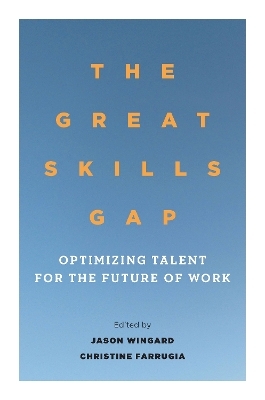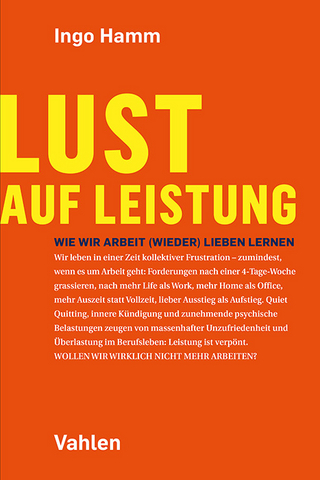
The Great Skills Gap
Stanford Business Books,US (Verlag)
978-1-5036-1353-9 (ISBN)
The Great Skills Gap opens with the premise that the exploding scope and pace of technological innovation in the digital age is fast transforming the fundamental nature of work. Due to these developments, the skills and preparation that employers need from their talent pool are shifting. The accelerated pace of evolution and disruption in the competitive business landscape demands that workers be not only technically proficient, but also exceptionally agile in their capacity to think and act creatively and quickly learn new skills.
This book explores how these transformative forces are—or should be—driving innovations in how colleges and universities prepare students for their careers. Focused on the impact of this confluence of forces at the nexus of work and higher education, the book's contributors—an illustrious group of leading educators, prominent employers, and other thought leaders—answer profound questions about how business and higher education can best collaborate in support of the twenty-first century workforce.
Jason Wingard is Dean Emeritus and Professor of Human Capital Management at Columbia University School of Professional Studies. He is the former Chief Learning Officer at Goldman Sachs and Vice Dean of the Wharton School, University of Pennsylvania. He is author of Learning to Succeed: Reinventing Corporate Education in a World of Unrelenting Change, and co-author of Learning for Life: How Continuous Education Will Keep Us Competitive in the Global Knowledge Economy (both with AMACOM, 2015).Christine Farrugia is Director of Research Initiatives at Columbia University School of Professional Studies.
Part I Introduction
—Neil Irwin
1. Equipping a New Generation with the Skills Needed in the Automation Age
—Susan Lund, Bryan Hancock
2. The Role of Citizen Developers in Developing Technological Literacy
—Lance Braunstein
3. The Future of Work: Four Difficult Questions I Need to Ask Myself as an Employer
—Matthew Pittinsky
4. Why Geography is So Important
—Michael L. Ulica
5. Enabling a High-Performing, Human-Centered Organization in Pfizer's Upjohn Division
—Amrit Ray, Lu Hong, Trish White
6. How the Future of Work Impacts the Workforce of Technical Organizations
—Gregory L. Robinson
7. Corporate Learning and Development Has a Vital Role to Play in the Robotics Revolution—Is It Ready?
—Uli Heitzlhofer
Part II Introduction
—Joseph Wiliams
8. Supporting Unlearning to Enable Upskilling
—Chris Dede
9. Higher Education's Changing Faces: Serving STEM Learners for a Lifetime
—Yakut Gazi, Nelson Baker
10. The Future of Business Education: New Economies of Automation, Certification, and Scale
—Anne Trumbore
11. "Back to the Future": Fragile Workers, Higher Education, and the Future Knowledge Economy
—Earl Lewis, Alford Young Jr., Justin Shaffner, Julie Arbit
12. Evolution of the Liberal Arts
—Christopher Mayer
13. The Evolution of Liberal Education in a Technology-Mediated, Global Society
—Kelly J. Otter
14. The Core and the Adult Student
—David Schejbal
15. Perpetual Learning as Alumni Engagement: Renewing the Social Contract
—Matthew Rascoff, James DeVaney
Part III Introduction
—Lauren Weber
16. Harnessing the Power and Potential of Diversity and Inclusion
—Stephanie Bell-Rose, Anne Ollen
17. Public Education and the Future of Work
—Ross Wiener
18. Developing Workers for the Workplace: How Businesses and Higher Education Can Alleviate Worker Barriers to Retraining or Upskilling
—X. Susan Zhu, Alexander Alonso, Johnny C. Taylor
19. Past is Prologue: Apprenticeship and the Future of Work
—Mary Alice McCarthy
20. Bachelor's-Level Registered Apprenticeship for Engineers: Possibilities and Challenges
—Daniel Kuehn
21. The Agility Imperative: The Future of Work and Business-Higher Education Partnerships
—Jason A. Tyszko, Robert G. Sheets
22. Demand for the "Blended Digital Professional"
—Brian K. Fitzgerald, Isabel Cardenas-Navia, Janet Chen
23. A Coherent Approach to Connect Education and the Future of Work
—LaVerne Srinivasan, Elise Henson, Farhad Asghar
Conclusion
—Jason Wingard, Christine Faruggia
| Erscheinungsdatum | 17.05.2021 |
|---|---|
| Zusatzinfo | 4 halftones, 12 figures, 10 tables |
| Verlagsort | Palo Alto |
| Sprache | englisch |
| Maße | 152 x 229 mm |
| Themenwelt | Wirtschaft ► Allgemeines / Lexika |
| Wirtschaft ► Betriebswirtschaft / Management ► Personalwesen | |
| Wirtschaft ► Betriebswirtschaft / Management ► Unternehmensführung / Management | |
| ISBN-10 | 1-5036-1353-4 / 1503613534 |
| ISBN-13 | 978-1-5036-1353-9 / 9781503613539 |
| Zustand | Neuware |
| Informationen gemäß Produktsicherheitsverordnung (GPSR) | |
| Haben Sie eine Frage zum Produkt? |
aus dem Bereich


